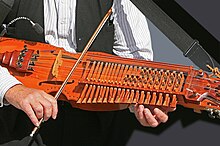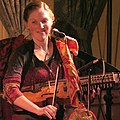music.wikisort.org - Instrument
A nyckelharpa (Swedish: [ˈnʏ̂kːɛlˌharːpa], "keyed fiddle", or literally "key harp", plural nyckelharpor) is the national musical instrument of Sweden.[1] It is a string instrument or chordophone. Its keys are attached to tangents which, when a key is depressed, serve as frets to change the pitch of the string.
This article uses bare URLs, which are uninformative and vulnerable to link rot. (August 2022) |
 | |
| Classification | Bowed string instrument |
|---|---|
| Hornbostel–Sachs classification | 321.322-71 |
| Related instruments | |
| Hurdy-gurdy | |
The nyckelharpa is similar in appearance to a fiddle or the big Sorb geige or viol. Structurally, it is more closely related to the hurdy-gurdy, both employing key-actuated tangents to change the pitch.[2]
History

A depiction of two instruments, possibly but not confirmed nyckelharpas, can be found in a relief dating from c. 1350 on one of the gates of Källunge Church in Gotland.[3][4] Early church paintings are found in Siena, Italy, dating to 1408 and in different churches in Denmark and Sweden, such as Tolfta Church, Sweden, which dates to c. 1460–1525. Other very early pictures are to be found in Hildesheim, Germany, dating to c. 1590.[citation needed]
The Schlüsselfidel (nyckelharpa) is also mentioned in Theatrum Instrumentorum, a famous work written in 1620 by the German organist Michael Praetorius (1571–1621). The Swedish province of Uppland has been a stronghold for nyckelharpa music since the early 17th century, including musicians like Byss-Calle (Carl Ersson Bössa, 1783–1847) from Älvkarleby.[4]
Changes by August Bohlin (1877–1949) in 1929/1930 made the nyckelharpa a chromatic instrument with a straight bow, making it a more violin-like and no longer a bourdon instrument.[4] Composer, player and maker of nyckelharpor Eric Sahlström (1912–1986) used this new instrument and helped to re-popularize it in the mid-20th century.[4] In spite of this, the nyckelharpa's popularity declined until the 1960s roots revival.[citation needed]
The 1960s and 1970s saw a resurgence in the popularity of the nyckelharpa, with notable artists such as Marco Ambrosini (Italy and Germany), Sture Sahlström, Gille, Peter Puma Hedlund and Nils Nordström including the nyckelharpa in both early music and contemporary music offerings. Continued refinement of the instrument also contributed to the increase in popularity, with instrument builders like Jean-Claude Condi and Annette Osann bringing innovation to the bow and body.[5]
In 1990s, the nyckelharpa was recognised as one of the instruments available for study at the folk music department of the Royal College of Music in Stockholm (Kungliga Musikhögskolan). It has also been a prominent part of several revival groups in the later part of the century, including the trio Väsen, the more contemporary group Hedningarna, the Finnish folk music group Hyperborea and the Swedish folk music groups Dråm and Nordman. It has also been used in non-Scandinavian musical contexts, for example by the Spanish player Ana Alcaide, the English singer and multi-instrumentalist Anna Tam, and Sandra Schmitt of Storm Seeker, a Pirate Metal band from Germany.[citation needed]
The first World Nyckelharpa Day took place on the 26th April 2020 just as the world had gone into lockdown. All the events took place online, either as livestreams or pre-recorded videos in Youtube. This now is a yearly event taking place on the Sunday closest to the 26th April - this being the birthday of the great nyckelharpa player Byss-Calle. The event is co-ordinated by British/Swedish nyckelharpa player Vicki Swan.[6]
Technique

The nyckelharpa is usually played with a strap around the neck, stabilised by the right arm. Didier François, a violinist and nyckelharpist from Belgium, is noted for using an unusual playing posture, holding the nyckelharpa vertically in front of the chest. This allows a wider range of motion for both arms. It also affects the tone and sound of the instrument. Some players may use a violin bracket to keep the nyckelharpa away from the body so that it can swing freely, causing it to sound more "open" as its resonance is not damped.[citation needed]
Variants
There are four common variants of the nyckelharpa still played today, differing in the number and arrangement of keys, number and arrangement of strings, and general body shape. The predominant type is the three-row so-called "chromatic nyckelharpa", with the melody strings tuned A1 - C1 - G, a drone C (from the highest to the lowest string) that is only touched occasionally, and 12 resonance strings (one for each step of the chromatic scale).
The other three variants are:[7][8]
- Kontrabasharpa - most popular during the 17th and 18th centuries. Typically the top has a high arch, and there are two oval-shaped soundholes in the lower bout called oxögon. The name "Kontrabasharpa" refers not to the pitch being any deeper than a standard nyckelharpa's (it isn't), but to the unstopped drone string which always resonates below the melody strings during regular play. The two melody strings are set up on either side of the drone string, such that melodies can be played as double stops between a single melody string and the open drone string without the two melody strings ever clashing.
- Silverbasharpa - most popular in the 19th and early 20th centuries, so named because of the bass strings which are traditionally wound with silver. It is the immediate predecessor to the modern nyckelharpa, and the string configuration is identical, however it retains the older top with a more pronounced arch as well as the two oxögon. The main difference is that only the top two strings are stopped, meaning that the bottom C and G strings cannot play any other notes, and so nearly all of its repertoire is in the key of C. In addition, some silverbasharpor may be diatonic and not chromatic, and some keys may stop both melody strings at once.[9]
- Oktavharpa - invented by Lennart and Johan Hedin in 1996. It is essentially a modern three-row nyckelharpa tuned an octave down, almost identical to a cello. It is the lowest-pitched variant of the nyckelharpa.
The resonance strings, or sympathetic strings, which were added to the instrument during the 2nd half of the 16th century, are not bowed directly but resonate with the other strings. There can be anywhere from six to twelve of them, depending on the construction and tonality of the instrument.
Some modern nyckelharpas have been made with four or even five rows of keys, however they have not been popular enough to replace the three-row nyckelharpa as the standard.
Gallery
- Angel with viola a chiavi ('keys'), Cappellina di Palazzo Pubblico, Siena, Italy. Fresco by Taddeo di Bartolo, 1408.
- Two angels with nyckelharpa, fresco in the church at Tolfa, Tierp Municipality, Uppland, Sweden. Unknown painter, 1503.
- Schlüsselfidel at the "Knochenhaueramtshaus", Hildesheim, Germany, 1529.
- Schlüsselfidel (lower right) shown in Michael Praetorius' Syntagma Musicum, 1619.
- Bronwyn Bird, member of Blue Moose, plays the nyckelharpa at a concert in 2007. Photo by georgie grd.
- Marco Ambrosini at Burg Fürsteneck, Germany, playing a nyckelharpa built by Annette Osann.
- Didier François teaching his special technique at the International Days of the Nyckelharpa at Burg Fürsteneck, 2005.
- Mia Gundberg Ådin (Huldrelokkk) playing the Nyckelharpa at the music festival Bardentreffen in Nuremberg, 2015.
Contemporary applications
English composer Natalie Holt used nyckelharpa for background score of the Disney+ series Loki.[10]
See also
- Hardanger fiddle
- Hurdy-gurdy
- Music of Sweden
- Moraharpa
References
- "National Instruments of Sweden". www.google.com. Retrieved 2022-09-13.
- Ternhag, Gunnar; Boström, Mathias. "The Dissemination of the Nyckelharpa - The Ethnic and the non-Ethnic Ways". STM-Online vol. 2 (1999). Retrieved 25 December 2018.
- Brashers, Bart. "A Brief History of the Nyckelharpa". American Nyckelharpa Association. Retrieved 25 December 2018.
- Broughton, Simon; Ellingham, Mark; Lusk, Jon (28 September 2006). The Rough Guide to World Music Vol. 1: Africa and the Middle East. Rough Guides. p. 299. ISBN 978-1-85828-635-8.
- "Nyckleharpa History". www.nyckelharpa.org. Retrieved 2022-09-13.
- "2020 – World Nyckelharpa Day". Retrieved 2022-09-15.
- "Nyckelharpa History".
- "Nyckelharpa – olov johansson".
- "The Nyckelharpa". nyckelharpansforum.net. Retrieved 2022-09-13.
- Burlingame, Jon (2021-07-01). "The Weird, Unsettling Music of Loki: Composer Natalie Holt Breaks Down the Marvel Series' Score". Variety. Retrieved 2022-09-15.
External links
- World Nyckelharpa Day
- The American Nyckelharpa Association
- International Days of the Nyckelharpa (Germany)
- Nyckelharpa.eu Nyckelharpa Cooperation in Europe
- Kornel Mariusz Radwanski plays The Alchemist's Dance on nyckelharpa with James Kline on archharp-guitar on YouTube
- Nyckelharpa Workshops and Teaching in the UK
- What is a Nyckelharpa? on YouTube
На других языках
- [en] Nyckelharpa
[es] Nyckelharpa
La Nyckelharpa (del sueco "clave-instrumento de cuerda") es un instrumento tradicional de origen sueco que en español suele denominarse viola de teclas. Es un instrumento de cuerda frotada. También recibe los nombres de Nyckelgiga, Nyckelspel y Nyckel-lira. Es similar a la zanfona y a la vihuela de arco.[1] El sonido característico de la Nyckelharpa surge de las cuerdas simpáticas que están debajo de las que se tocan. Se coloca más o menos como una guitarra y el arco vertical enfrentado al abdomen del intérprete.[ru] Никельхарпа
Никельхарпа (нюкельхарпа, никельарфа, швед. nyckelharpa) — традиционный шведский музыкальный инструмент, имеющий несколько модификаций, поскольку развивался более 600 лет. Самым первым свидетельством использования никельхарпы считается изображение двух музыкантов, играющих на этом инструменте, которое находится на портале над входом в церковь Челлунге (швед.) (рус. на острове Готланд и датируется приблизительно 1350 годом[1]. В шведском слово «nyckel» означает «клавиша»[2], слово «harpa» — «арфа»[3]. Иногда никельхарпу называют «шведской клавишной скрипкой». Современная хроматическая никельхарпа имеет 16 струн: 3 струны мелодии, одну монотонную струну, и 12 резонансных струн, а также около 37 деревянных клавиш, устроенных так, чтобы скользить под струнами. У каждой клавиши есть салазки, скользя по которым она достигает верха и зажимает струну, меняя её звучание. Исполнитель использует короткий смычок правой рукой, зажимая клавиши левой. Никельхарпа имеет диапазон 3 октавы (от самого низкого «соль» как 4-я струна скрипки) и звучит наподобие скрипки, только с гораздо большим резонансом. В Финляндии никельхарпа известна под именем «avainviulu»Другой контент может иметь иную лицензию. Перед использованием материалов сайта WikiSort.org внимательно изучите правила лицензирования конкретных элементов наполнения сайта.
WikiSort.org - проект по пересортировке и дополнению контента Википедии







